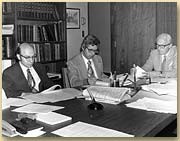The idea of merging Sir George Williams University and Loyola College was discussed informally and sporadically. In 1968 a Loyola-Sir George Joint Steering Committee was established to investigate the various possibilities of federation, merger and so on. In 1969 there was a formal proposal put forward to the Steering Committee by Donald Savage, a Loyola history professor, and Michel Despland, the assistant dean of Arts at Sir George Williams (Proposed federation of Loyola College and Sir George Williams University, June 13, 1969, revised September 30, 1969). They recommended creating a "Federal University" that would allow students to take courses at both campuses without paying additional fees, and they introduced the idea of a bus service between Loyola and Sir George Williams.
Merger of Loyola College and Sir George Williams University

When you join together two lively institutions, each with its own philosophies and ways of doing things, each firmly dedicated to freedom of thought and speech, you must expect a measure of friction. We look forward now to a new period of creative friction.
The notion of federating the two institutions brought a hail of criticism about the difficulties of combining existing faculties and departments from both institutions, but the concept did not disappear. The Joint Committee of Representatives of the Board of Trustees of Loyola and the Board of Governors of Sir George Williams University was created in December 1971 and in the fall of 1972 it produced the document, A Model for the New University, which proposed the establishment of a two-campus university under the Sir George Williams University charter. Revisions were made to this document on November 8, 1972. The document was to become the blueprint for the merger, and it was approved by the Board of Trustees of Loyola College on November 8 and by the Board of Governors of Sir George Williams on November 9, 1972. Sir George Williams and Loyola began making plans for the eventual merger.
Preparing for the merger involved structural and administrative changes for both Loyola and Sir George Williams. In early 1973, a joint advertising campaign made the agreement public, and it was expected that the new university would be in operation for the beginning of the fall term. However, the legal and administrative arrangements took longer than anticipated.
The formal arrangements to establish the new university as a legal entity were as follows:
- The new university would be operating under the charter and corporation of Sir George Williams, therefore certain changes were required. On August 10, 1973, the Corporation of Sir George Williams University adopted Special Bylaw "C" which enacted a change of name to Concordia University - Université Concordia. Bylaw "D" was also adopted, which established the governing and administrative structure of the new university. The meeting was adjourned. A new meeting was convened at which the corporation and Board members resigned and elections were held for new members of the Corporation and of the Board of Governors of Concordia University, in conformity with the revised structure.
- On August 14, 1974 Special Bylaw "C" was approved by the Quebec Minister of Financial Institutions, Companies and Cooperatives.
- On August 16, 1974, an Agreement of Transfer and Assignment was signed in which the assets of Loyola College were sold to the new university.
- On August 24, 1974, notice of approval of Bylaw "C" was published in the Quebec Official Gazette (Vol. 106, no. 34, p. 6012), and with this publication the new university legally became known as Université Concordia and its English version Concordia University.
Loyola College and Sir George Williams University had joined forces to become Concordia University.

